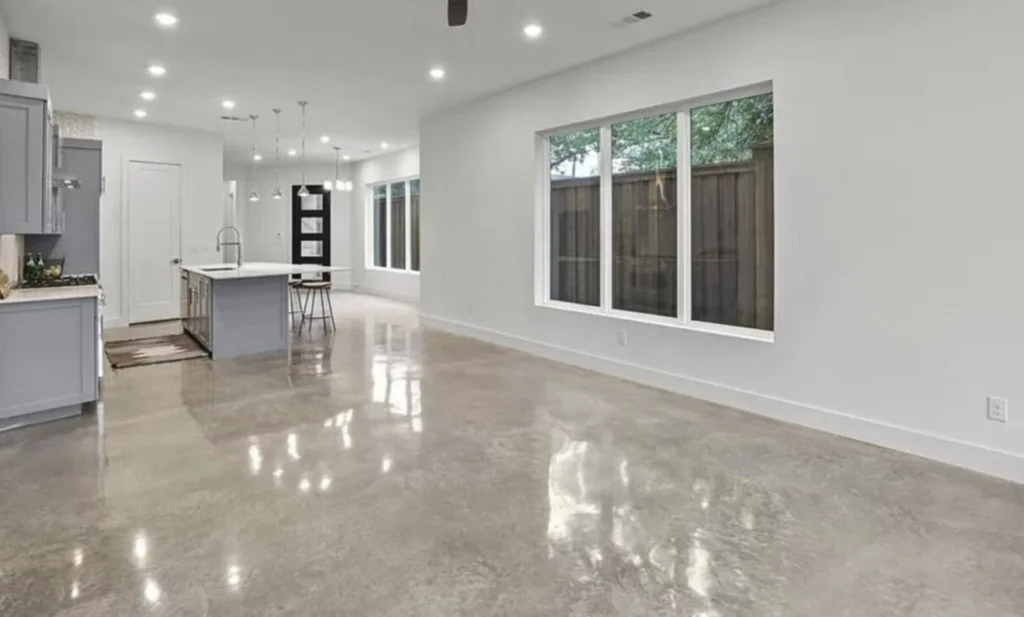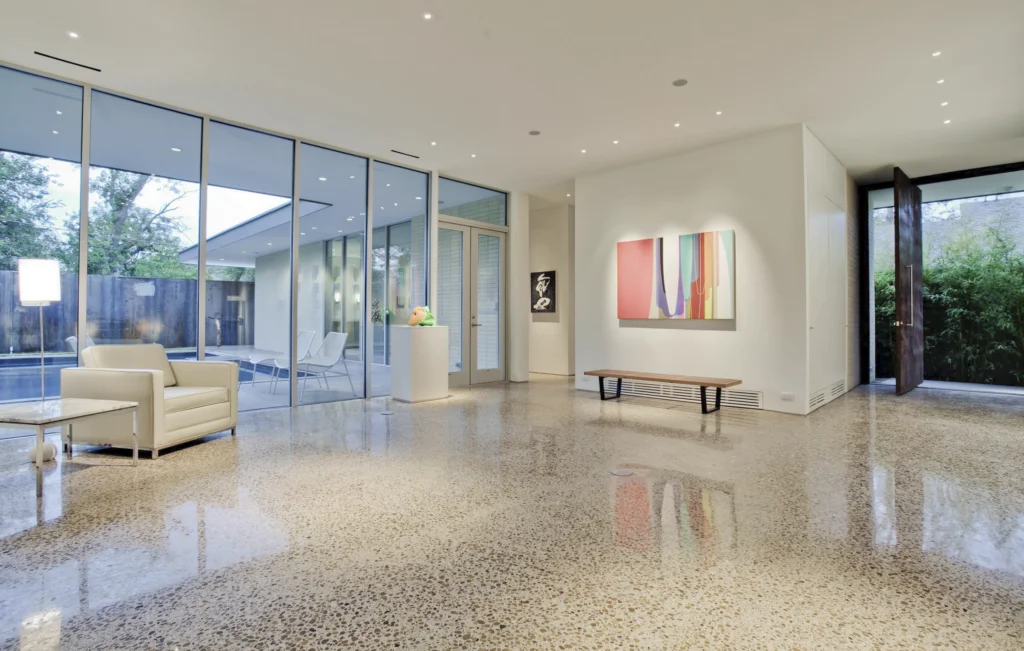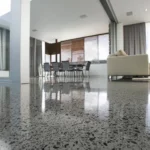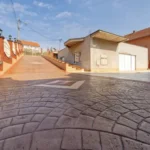Polished concrete floors are rising in popularity among homeowners, particularly those looking for modern, minimalistic, and durable flooring options. But with the growing appeal comes a list of questions and concerns: “Is polished concrete cold?”, “Is it safe?”, “How much maintenance does it need?”
In this comprehensive guide, we’ll address frequently asked questions about residential polished concrete, along with the pros and cons, so you can make an informed decision.
Polished concrete floors have transitioned from industrial settings to become a top choice for residential spaces, especially in modern and upscale homes. With their sleek appearance, durability, and low maintenance requirements, they’re a practical and attractive flooring option. But as with any major design choice, homeowners naturally have questions and concerns. Let’s delve into what polished concrete can bring to your home and address the common questions that come with it.
What Is Residential Polished Concrete?
Polished concrete involves grinding down a concrete slab to create a smooth, glossy surface, typically sealed to enhance durability and stain resistance. Residential polished concrete differs slightly from its commercial counterpart, usually emphasizing aesthetics and comfort to suit home interiors.
Advantages of Polished Concrete Floors
1. Low Maintenance
Polished concrete is ideal for homeowners seeking low-maintenance options. Regular sweeping and occasional mopping are generally all that’s needed to keep the floors looking pristine.
2. Eco-Friendly Choice
Polished concrete ranks high in sustainability since it often utilizes the existing concrete slab, reducing the need for additional materials. Plus, it involves no harsh chemicals or synthetic materials, making it a greener choice.
3. Aesthetic Versatility
With an array of finishes, colors, and decorative options, polished concrete can be customized to suit any home style—from rustic to ultra-modern.

4. Cost-Effective Over Time
While the initial installation may be higher than other flooring options, polished concrete’s durability means fewer replacements and repairs over time.
Disadvantages of Polished Concrete Floors
1. Coldness and Hardness
Polished concrete can feel cold, especially in cooler climates, and the hard surface may be uncomfortable for long periods of standing. Area rugs or radiant heating can help address these issues.
2. Initial Installation Cost
Compared to traditional flooring options like carpet or laminate, polished concrete can be pricier upfront, though the long-term savings often justify the investment.
3. DIY Challenges
Polishing concrete requires specialized tools and expertise, making it difficult to tackle as a DIY project. Hiring professionals is highly recommended.
Common Concerns About Polished Concrete Floors
Are Polished Concrete Floors Slippery?
Polished concrete can be slippery when wet, similar to other hard surfaces. Adding a slip-resistant sealer can increase safety, making it less slippery than some other flooring types.
Do Polished Concrete Floors Crack?
Yes, concrete floors are prone to cracking over time. However, these natural cracks are often seen as part of the floor’s character and aesthetic appeal.
Are They Prone to Dampness?
Most polished concrete floors have moisture barriers that prevent dampness. Older homes may have dampness issues, but polishing allows moisture to escape naturally, preventing further damage.
Frequently Asked Questions
Are Polished Concrete Floors Loud?
Yes, hard surfaces like polished concrete can amplify sound. This can be countered by using sound-absorbing materials like rugs, curtains, or wall hangings.

How Pet-Friendly Are Polished Concrete Floors?
Polished concrete is incredibly pet-friendly due to its scratch-resistant nature and ease of cleaning. However, it’s essential to clean up pet accidents promptly to avoid stains.
How Do Polished Concrete Floors Impact Home Value?
Polished concrete can enhance home value by offering a modern, durable, and eco-friendly flooring option. Its longevity and aesthetic appeal often make it a selling point for potential buyers.
Polished Concrete Maintenance Needs
Despite its low maintenance, polished concrete isn’t maintenance-free. Routine cleaning with a mild cleaner is essential, especially in high-traffic areas. Sealing every few years can help maintain the shine and protect against staining.
Cost Factors for Residential Polished Concrete
The initial cost of polished concrete can vary based on factors like slab condition, desired finish, and home location. Compared to tile or carpet, it may seem pricier initially but becomes cost-effective over the years due to its durability.
Eco-Friendliness of Polished Concrete
Since polished concrete typically utilizes the existing slab, it has a lower environmental impact than other flooring options. It’s also an energy-efficient choice, as concrete can help regulate indoor temperatures.
Comparing Polished Concrete to Other Flooring Options
- Polished Concrete vs. Tile: While both are durable, polished concrete is less prone to chipping and requires less maintenance.
- Polished Concrete vs. Wood: Wood floors offer warmth but require more upkeep and are less pet-friendly.
- Polished Concrete vs. Carpet: Carpet offers comfort but has a shorter lifespan and is harder to clean than polished concrete.
Is Polished Concrete Safe for All Homeowners?

Polished concrete can be safe for all household types, including families and pet owners. However, it may be less ideal for individuals who prioritize comfort over durability, as it’s less forgiving underfoot.
Can You Polish Concrete Yourself?
Polishing concrete is a highly technical task that requires specialized equipment and expertise. DIY attempts may result in an uneven finish, so hiring a professional is strongly recommended.
Aesthetic Options for Polished Concrete
Polished concrete can be customized with dyes, stains, and etchings, allowing homeowners to create a unique look. This versatility enables it to complement any design aesthetic.
How Polished Concrete Affects Indoor Temperature
Concrete retains heat and can help regulate indoor temperatures. Homes in colder regions can benefit from installing radiant heating in the concrete slab to keep the floor comfortably warm.
Conclusion
Polished concrete floors offer a beautiful, durable, and eco-friendly option for homeowners. While they come with some potential drawbacks, such as coldness and the need for professional installation, their aesthetic appeal and long-term cost savings make them a worthwhile consideration.
FAQs
1. Are polished concrete floors easy to clean?
Yes, polished concrete floors are very easy to clean and require minimal maintenance.
2. Can polished concrete be used in bathrooms?
Yes, it can be used in bathrooms, but consider adding a non-slip finish to avoid slippery conditions when wet.
3. How long do polished concrete floors last?
With proper care, polished concrete floors can last for decades, making them one of the most durable flooring options available.
4. Are polished concrete floors comfortable for children?
They’re quite durable, but the hardness may not be comfortable for crawling or long periods of play.
5. Can you change the color of polished concrete later?
Yes, the color can be altered with stains or dyes, allowing for customization over time.



